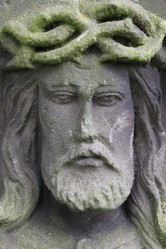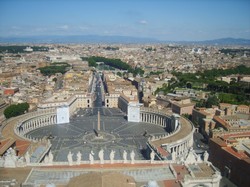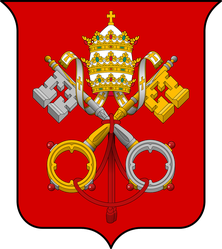The trouble with being a religious leader is that your mistakes are promulgated through the centuries, and this is what happened to Gregory the Great. In an eleventh century sermon he made a blunder. Speaking of Mary Magdalene he rolled four women into one: Mary of Magdala; Mary of Bethany [sister of Lazarus], who anointed Jesus before he died; the woman who was a sinner, in Luke 7; and later clerics have thrown in the woman taken in adultery for good measure. It was only in 1969 that the church admitted that these were separate women, but the error still lingers. Another error is the claim that Mary was a converted prostitute. There is no evidence for this.
One of the problems when dealing with biblical documents is that the documents emphasize Christ, and the followers play themselves down. Thus Mary, Jesus' mother, gets some good press, but then seems to take a background role. The apostles are mentioned, but only a few are mentioned much; and the women fade into the background and just get on with living. We can see that this must be so, as the New Testament is Christ-focused, but there are times when we want to know about his followers. So what do we know of Mary's origins?
We know that she came from Magdala, on the Sea of Galilee, a place which means Tower of the Salted Fish. We also know that she had seven devils cast out of her, after which she tagged along with Jesus' apostolic band, where she became a key companion. We do not know what was wrong with her: mental illness, possession, or physical ailment. But we do know that she was one of the wealthy women who backed up Jesus' mission with her money and helped to care for the males. Having wealth like this in her own right would, in a time when women had no rights, indicate that she was a wealthy widow, but we cannot know this.
We do know that she was present at the cross, to keep vigil with Jesus till his death. She watched the burial and on the Sunday morning went early to the tomb. The city gates were closed at night and opened at dawn, so,as she went when it was still dark, we infer that she went very early, just after the first rays of the sun brightened the sky.
The gospels present her as going with a band of women, but John's gospel focuses on her alone. She warns the apostles that the tomb is empty, but she thinks that it has been robbed of the body. Later,when she returns to weep she meets Jesus,but thinks that he is the gardener, until he addresses her by name. She knows him by his voice and she goes to embrace him, but he demurs saying that he has not yet ascended to his Father. All of this indicates that she had an intense, loving relationship with Jesus.
After this she fades from history, for she is mentioned in Acts of the Apostles as being among the early church when the Holy Spirit arrived at Pentecost; and then she is gone from the records. She sought no fame or power, for to Mary love was enough, but she ever goes down in history as Apostle to the Apostles, the only female to be ascribed apostolic rank.







 Pilgrimage. A review25 days ago
Pilgrimage. A review25 days ago
 Leo the Fourteenthon 05/09/2025
Leo the Fourteenthon 05/09/2025
 The Melsonby Hoardon 03/25/2025
The Melsonby Hoardon 03/25/2025




Comments
I suspect that hevwasvfrom Maryz's sides.
Please accept my apologies if the observation and the question below appear twice since the computer acted as if I signed out as I asked the question ;-{!
It's interesting that two Marys invoke the Holy Family by Mary of St. Joseph's brother Cleophas' wife and by Our Lady Mary.
So I mulled whether or not Mary Magdalene might represent someone familial.
Was Joseph of Arimathea perhaps related to Our Lady Mary's father or mother? Would a maternal or a paternal uncle have different or similar responsibilities toward a nephew?
Question of Mary .Magdalene being related to Joseph of Arimathea.Joseph was said to be
Jesus' uncle, probably on Mary's side, while Clopas who is mentioned in Luke, was St Joseph's brother, according to Eusebius, the church historian. Hence related on the paternal side.
Possibly. But web do not know.
Thank you for your comment below in answer to my previous, same-day question.
Mary Magdalene must have mattered to Jesus Christ since she numbered among such known Crucifixion attendees as Our Lady Mary.
Would it be possible for her being related to Our Lady Mary or to St. Joseph or to Joseph of Arimathea?
The gospels are a lifetime's study.
Thank you for your comment below in answer to my previous observation and question!
It's interesting to know about rearranged gospels. Is it known the when, who and why of the adulterous woman (and man ;-D!) tale traveling into the St. Luke gospel and then trekking into the St. John?
Her name is not known. A common feminist question is what happened to the adulterous male, who was liable for punishment, but we don't know. Maybe he. was one of Herod''s officers and could be protected by his boss. Bear in mind that while the tale seems to be set in Jerusalem, the story fits into a Gallean ambience, as it makes no reference to the temple.. thisbputs it squarely into territory ruled by Herod Antipas. The story was an independent tradition which did not fit into a gospel but finally settled down in John's gospel, after a brief sojourn in Luke.so who can tell what area it was set in?
Thank you for the two comments below on April 13, 2023, in answer to my previous, same-day observations and questions.
So Mary Magdalene answers whoever asks about the woman assailed by seven devils.
Does Christian tradition associate the woman, whose adultery Jesus Christ assured as avoiding stoning penalties, with any known female name from His time?
(Would it just have been she being punished or would her co-adulterer have been punished likewise?)
I am unsure about relationships in the royal family, which does not hold my attention. I suspect that some members of Jesus' family foĺlowed him, and It is said that the younger James resembled Jesus, but we have no proof of these claims.